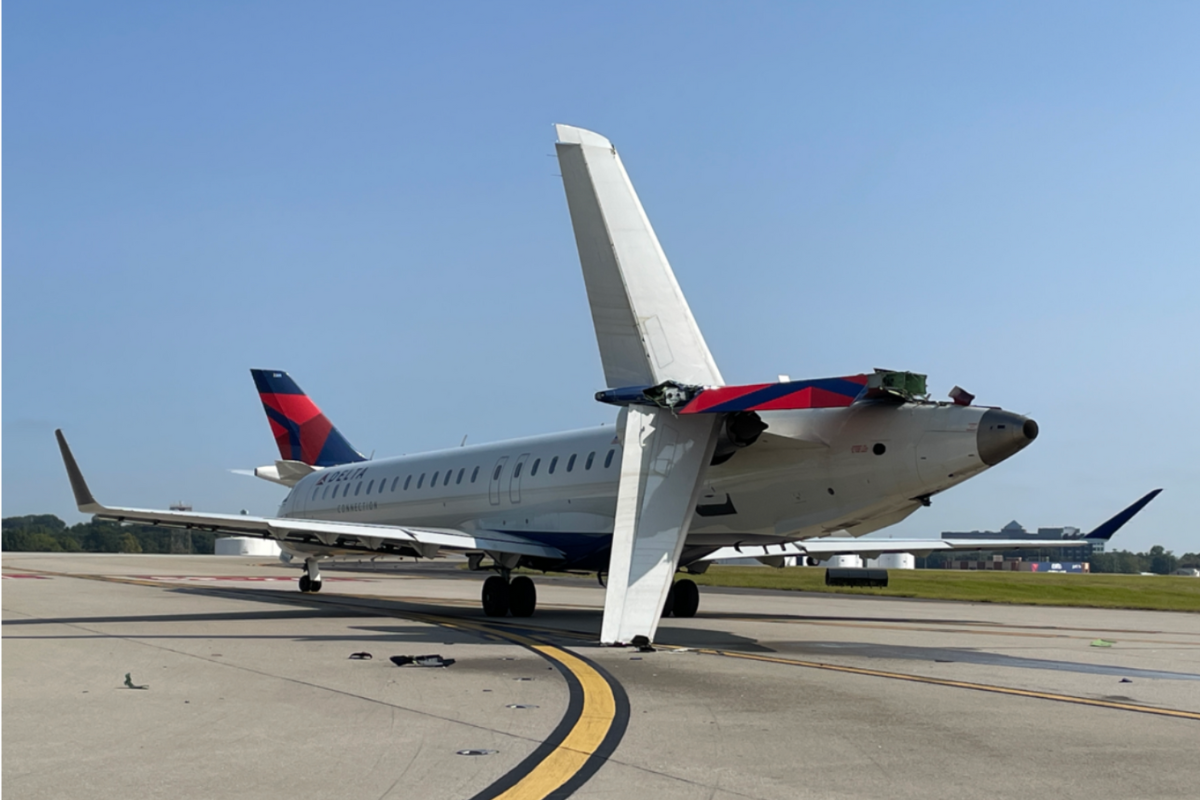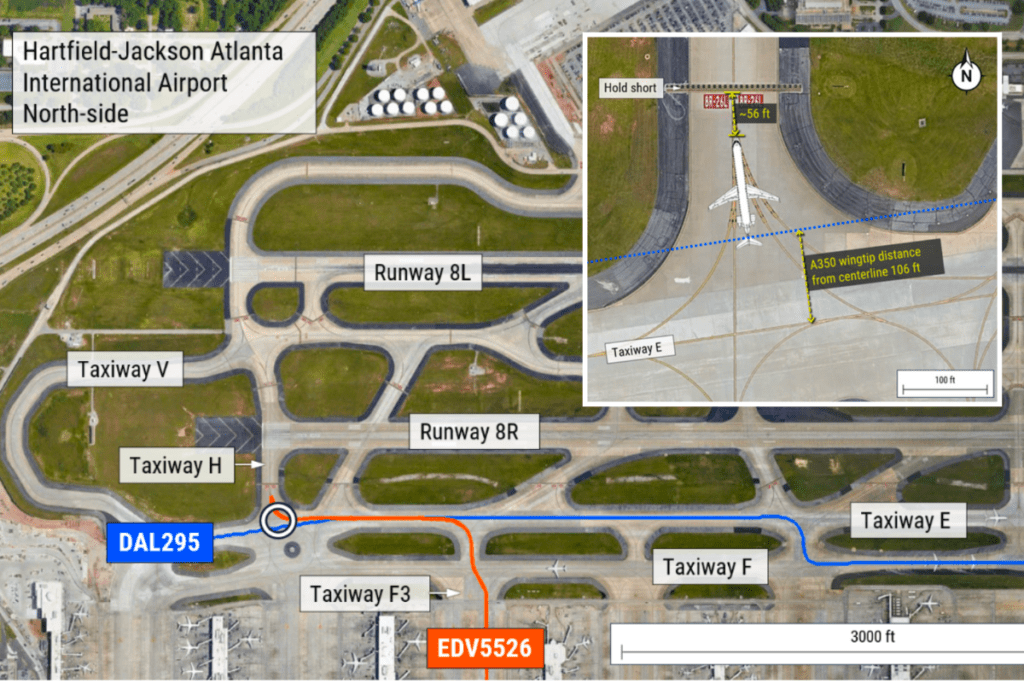
A preliminary accident report has revealed that an extraordinary accident at Atlanta Hartsfield International Airport, in which the tail of a Delta Air Lines regional jet was sliced off by the wing of a passing Airbus A350 widebody jet, could have been caused by the pilots of the smaller airplane stopping too short of the runway.
On Tuesday, the National Transportation Safety Board (NTSB) released its preliminary report on the September 10 accident, and while investigators have yet to draw any conclusions, it’s been revealed that the smaller plane stopped short of the runway entrance by around 56 feet.

As a result, the tail of the smaller CRJ regional jet was just within striking distance of the wing tip of the passing Airbus A350.
The accident occurred when both planes were taxiing for departure at the world’s busiest airport during the early morning rush.
The CRJ-900 regional jet was operated by Endeavor Air, which is owned by Delta Air Lines and operates the carrier’s Delta Connection branded regional flights. The decades-old jet was taxiing for departure for a flight between Atlanta and Lafayette at around 10 am.
Just behind it was the Delta Air Lines Airbus A350 with 221 passengers onboard which was taxiing for departure as flight DL295 to Tokyo Haneda
The CRJ regional jet was holding short of Runway 8R on Taxiway H as it waited for clearance to enter the runway and takeoff, while the Airbus A350 was taxiing along intersecting Taxiway E. As the A350 passed the intersection point, its right-hand wing collided with the tailfin of the regional jet.
At the time of the accident, the normal runway used for widebody aircraft was closed for construction work, so the pilots had to depart from Runway 8R. The pilots were initially instructed to follow the CRJ which was taxiing ahead of it along Taxiway E before the regional jet turned onto Taxiway H.
Due to a potential maintenance issue, the A350 pilots were instructed to proceed further along Taxiway E and pass the regional jet. The Captain of the A350 told investigators that he was looking straight ahead and to the left to avoid a potential conflict with traffic on an adjacent taxiway.
What the Captain of the A350 didn’t notice, however, was that the right-hand wingtip was about to collide with the regional jet.
According to Endeavour Air, the nose of the regional jet was around 56 feet from the ‘hold short’ line of Runway 8R when the accident occurred. No conclusions have been drawn by investigators but this information does raise the possibility that the pilots of the regional jet did not stop far enough towards the ‘hold short’ line.
The collision resulted in the tail of the regional jet being ripped off, although only minor damage was caused to the A350. Of the 296 passengers and crew on both planes, only one flight attendant on the regional jet sustained a minor injury.
The investigation into the accident continues.
Mateusz Maszczynski honed his skills as an international flight attendant at the most prominent airline in the Middle East and has been flying ever since... most recently for a well known European airline. Matt is passionate about the aviation industry and has become an expert in passenger experience and human-centric stories. Always keeping an ear close to the ground, Matt's industry insights, analysis and news coverage is frequently relied upon by some of the biggest names in journalism.








No, the “dramatic accident” was caused by the Captain of the A350 hitting another airplane on the ground.
More to the point, the FO on the A350 failing to look out the window and clear the wing. But, ultimately it’s the Captain’s responsibility.
You hit a parked car… is it the parked car’s fault?
That is a 100 percent false conclusion. As a 22 year A320 captain I can say there is NO requirement for a plane to be right at the runway edge when holding short of the runway. This is completely the delta A350 crew’s fault. This is just like a car accident, if someone is stopped at a stop light it doesn’t matter where they are stopped, if you hit a stopped vehicle it is completely your fault.
The hold short line means you cannot cross it… doesn’t mean you’ve gotten inch up to have the nose right at the line. It’s a “do not exceed” point. Depending on angle of taxiway and even traffic that was in front of the RJ and departed, who is to say the RJ wasn’t where it was for safety reasons? So the pilots had a good view out to final, or to avoid jetblast from an earlier departure. Or that they weren’t moving forward while they handled something in the flight deck that wasn’t safe to do with wheels turning?
The A350 crew apparently had asked if they could stop while dealing with MX Control but were told by ATC they couldn’t stop there. So they did the task anyway, taking F/O’s eyes off the outside.
The A350 was taxiing on the centerline. I’m sure that the 22 year A320 captain knows that. We beat that centerline into the heads of pilots DAILY in training. That centerline is surveyed to provide proper clearance on all aircraft. Same thing at the gate. The gates are “certified” for certain aircraft. The A380, for instance, is only allowed on certain taxiways, gates and runways. While I do not teach the A320, every commercial aircraft I’ve taught, some (like the Boeing 777, even the Boeing 737) it is almost impossible to see the wingtips from the cockpit. Thus….the CENTERLINE guarantees wingtip clearance. The regional jet was by itself on taxiway H. Had there been another aircraft behind it, ground would have had the A350 stop because there was not enough clearance to pass behind. Had the regional jet pulled forward to the hold short line, there would have been no issues.